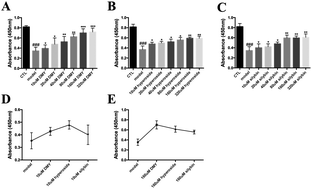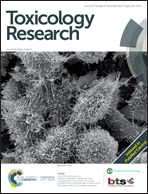Phytochemicals protect L02 cells against hepatotoxicity induced by emodin via the Nrf2 signaling pathway†
Abstract
Dihydromyricetin (DMY), hyperoside and silybin are phytochemicals that belong to a class called flavonoids, and they have been used in liver protection pharmaceutical preparations, but the specific mechanism of these chemicals is still unclarified. This study aims to investigate the hepatoprotective effects and potential mechanism of these phytochemicals. The immortalized human hepatocyte cell line L02 was treated with 200 μM emodin for 48 h, and this was used as a hepatocyte injury model. The L02 cells were treated with both 200 μM emodin and different concentrations of DMY/hyperoside/silybin for 48 h to investigate the protective effects of these phytochemicals. The CCK-8 assay was used to detect cell viability. RT-qPCR and western blotting were performed to examine the mRNA and protein expression, respectively, of the classic bile acid synthetic pathway gene CYP7A1, the bile acid efflux transporter bile salt export pump (BSEP), the nuclear factor erythroid-2-related factor 2 (Nrf2) and the drug processing gene CYP1A2. DMY, hyperoside and silybin prevented the impairment of cell viability that was caused by emodin-induced hepatotoxicity in a dose-dependent manner, and at a low concentration (10 μM), the protective effect followed the order hyperoside > DMY > silybin, while at a high concentration (160 μM), the protective effect followed the order DMY > hyperoside > silybin. These phytochemicals reduced the expression of CYP7A1 at both the mRNA and protein levels. BSEP was not influenced by the phytochemical intervention. When 200 μM emodin was used for 48 h with the addition of the phytochemicals at 200 μM, the nuclear protein expression of Nrf2 significantly increased and CYP1A2 expression decreased. DMY, hyperoside and silybin prevented the hepatotoxicity induced by emodin in the L02 cells, potentially, via the Nrf2 signaling pathway.



 Please wait while we load your content...
Please wait while we load your content...